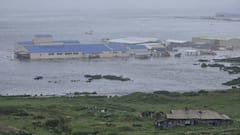Japan Begins Twin Investigations Into Collision At Tokyo's Haneda Airport That Killed 5
Japanese investigators have begun a probe into Tokyo's Haneda airport crash which killed five people along with France where the aircraft were made and Britain where the engines were manufactured.

An investigation has been initiated into the crash at Tokyo’s Haneda airport, by Japan's transport authorities where two aircraft collided on Tuesday night killing five of the six crew members. They have begun probing the charred remains of the passenger jet and the coast guard plane, reported Reuters. Meanwhile, the report added citing local media that police were also investigating possible professional negligence in the case.
All 379 people aboard a Japan Airlines (9201.T) Airbus A350 survived after the collision with a De Havilland Dash-8 Coast Guard turboprop, reported Reuters. However, five out of six crew members on the smaller aircraft lost their lives.
The probe will be led by the Japan Safety Transport Board (JTSB), with support from agencies in France (where the airplane was built) and Britain (where its two Rolls-Royce engines were manufactured). Meanwhile, the experts have cautioned that it is premature to pinpoint the cause of the accident, as most incidents arise from a combination of factors.
According to the report, investigators will examine the instructions given to both aircraft and conduct a detailed examination of the plane and airport systems. Their first task will be to recover the black box recorders containing flight data and cockpit voice recordings. As per the report, a Japanese ministry official mentioned that the A350 was attempting a normal landing when it collided with the Coast Guard plane, also known as a Bombardier Dash-8.
Experts believe that the accident site's location means physical evidence, radar data, witness accounts, or camera footage will likely be readily available, facilitating the extensive forensic investigation, as reported by Reuters.
Paul Hayes, director of aviation safety at the UK-based consultancy Ascend by Cirium, emphasised one crucial question: whether the coastguard aircraft was on the runway and, if so, why.
The recent collision marks the first major incident involving the Airbus A350, Europe's leading twin-engined long-haul aircraft operational since 2015. It occurred despite the aviation industry experiencing one of its safest years in 2023, according to preliminary data, involving a Coast Guard plane and a two-year-old jetliner three times its size, the report added.
Last month, a US-based safety group warned about the risk of runway collisions or "incursions." The Flight Safety Foundation, as reported by Reuters, urged global action to prevent a potential rise in runway incursions due to increasingly congested skies.
Hassan Shahidi, the CEO, stated, "Despite efforts over the years to prevent incursions, they still happen." He highlighted the severe consequences of runway incursions, emphasising their global concern.
While ground collisions causing injury or damage have notably decreased, their potential for fatalities remains among the highest in aviation incidents. Near-misses in such scenarios are more common, the report further said.
The foundation highlighted breakdowns in communication and coordination as factors contributing to runway crashes or near misses. It said the concern isn't the lack of airborne collision avoidance software, available since the 1980s, but the scarcity of ground-based electronics designed to prevent runway collisions, raising significant concerns.
ALSO READ | Screams, Panic, Chaos: Videos Show Japan Passengers' Terrifying Experience Inside Burning Plane
Top Headlines







































